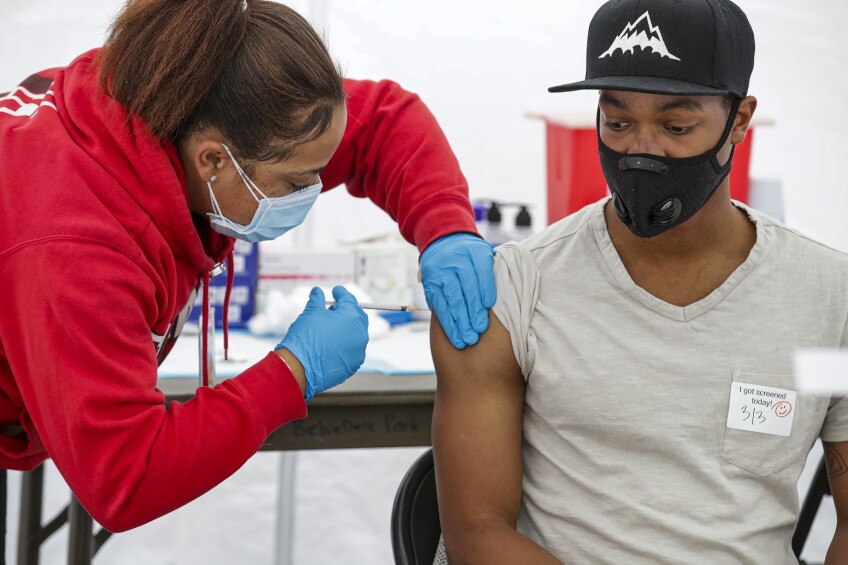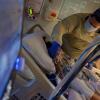State Sets Aside Vaccines for Hard-Hit Areas, Speeds Reopening Efforts

LOS ANGELES (CNS) - Southern California counties and others across the state could be cleared to open more businesses and lift other restrictions sooner than anticipated under a plan announced today that will prioritize COVID-19 vaccines in communities hardest hit by the pandemic.
Fueling the plan is a move announced by Gov. Gavin Newsom to set aside 40% of the state's vaccine doses for hard-hit communities, generally those that are lower income and have had higher infection rates and lower numbers of residents getting vaccinated.
"With more vaccines online and administered, California is now in a position to take steps toward ending this pandemic by keeping our guard up and by vaccinating those Californians most at risk and most exposed," Newsom said in a statement Thursday. "Vaccinating our most impacted communities, across our state, is the right thing to do and the fastest way to end this pandemic."
As the state makes progress in vaccinating lower-income residents, it will in turn ease the requirements counties need to meet to advance through Newsom's "Blueprint for a Safer Economy," the four-tiered color-coded system that regulates the opening, closure and capacity limits for businesses based on a county's rate of new COVID infections and testing positivity rates.
We will defeat it. We will turn the proverbial page. We are doing so, but let us please maintain our vigilance as we work through and get to the herd immunity.Gov. Gavin Newsom
All Southern California counties are currently in the most restrictive "purple" tier of that blueprint, and thus are subject to the tightest economic restrictions, including low-capacity limits at retail stores and forced closures of movie theaters, indoor restaurants and indoor fitness centers. To advance to the less-restrictive "red" tier, a county's rate of daily new COVID cases has to drop to at least 7 per 100,000 residents, and the testing positivity rate must fall below 8%.
Under the state policy shift announced Thursday, the required case rate need to advance in the blueprint and loosen restrictions on businesses will be eased once the state distributes 2 million vaccine doses to hard-hit communities across the state. That is expected to occur in the next two weeks, since the state has already delivered 1.6 million doses to those communities.
The case rates needed to advance in the economic blueprint will be adjusted again when the state reaches 4 million doses to the hard-hit communities.
Easing the case-rate restrictions means counties will be able to move more quickly through the four tiers of the blueprint and authorize more businesses to reopen and at higher capacities.
In making the announcement, state officials noted that COVID infection rates among households that earn less than $40,000 a year are more than double those of households with an income of $120,000 or more. Wealthier residents, however, are being vaccinated at nearly double the rate of lower-income communities.
In addition to earmarking 40% of the state's vaccine supply to hard-hit communities, the state will also reserve vaccine-appointment slots for those communities and increase funding to boost the number of vaccine providers.
Newsom previewed the plan on Wednesday during a visit to Long Beach, where he stressed that the state wasn't eliminating the economic tier system, simply adjusting the thresholds to take vaccination efforts into account.
"We want to incorporate vaccination rates into the tiering, and that will allow people to move more quickly through the tiers," he said.
He touted the continued downward trend in COVID numbers statewide, saying the current rate of people testing positive for the virus has dropped to 2.2%, among the lowest rates in the nation.
But he insisted the pandemic is not over, and said it is too early for people to stop wearing masks or practicing social distancing. He noted the continued emergency of COVID variants that can spread more quickly and could lead to another surge in cases.
"That's why it's essential and incumbent that we not put down our guard, moreover, remove our masks as it relates to addressing the transmissibility of this disease that is still taking thousands of lives every single day — hundreds of lives lost every single day here in the state ofCalifornia," Newsom said. "It is a deadly disease. It is not taking spring break off. It has not taken a day off since this time last year.
"We will defeat it. We will turn the proverbial page. We are doing so, but let us please maintain our vigilance as we work through and get to the herd immunity."








